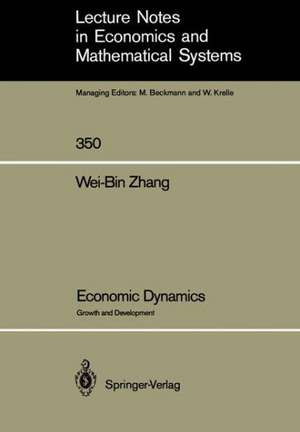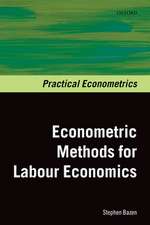Economic Dynamics: Growth and Development: Lecture Notes in Economics and Mathematical Systems, cartea 350
Autor Wei-Bin Zhangen Limba Engleză Paperback – 14 noi 1990
Din seria Lecture Notes in Economics and Mathematical Systems
-
 Preț: 360.02 lei
Preț: 360.02 lei -
 Preț: 383.93 lei
Preț: 383.93 lei -
 Preț: 384.09 lei
Preț: 384.09 lei -
 Preț: 380.07 lei
Preț: 380.07 lei -
 Preț: 446.26 lei
Preț: 446.26 lei -
 Preț: 497.37 lei
Preț: 497.37 lei -
 Preț: 380.84 lei
Preț: 380.84 lei -
 Preț: 384.86 lei
Preț: 384.86 lei -
 Preț: 378.34 lei
Preț: 378.34 lei -
 Preț: 399.67 lei
Preț: 399.67 lei - 20%
 Preț: 360.93 lei
Preț: 360.93 lei - 15%
 Preț: 643.16 lei
Preț: 643.16 lei -
 Preț: 379.09 lei
Preț: 379.09 lei -
 Preț: 404.74 lei
Preț: 404.74 lei -
 Preț: 385.62 lei
Preț: 385.62 lei - 15%
 Preț: 644.49 lei
Preț: 644.49 lei -
 Preț: 379.09 lei
Preț: 379.09 lei -
 Preț: 345.50 lei
Preț: 345.50 lei -
 Preț: 425.80 lei
Preț: 425.80 lei -
 Preț: 378.34 lei
Preț: 378.34 lei - 18%
 Preț: 775.65 lei
Preț: 775.65 lei -
 Preț: 392.60 lei
Preț: 392.60 lei -
 Preț: 401.61 lei
Preț: 401.61 lei - 15%
 Preț: 646.43 lei
Preț: 646.43 lei -
 Preț: 382.18 lei
Preț: 382.18 lei -
 Preț: 378.34 lei
Preț: 378.34 lei - 15%
 Preț: 637.59 lei
Preț: 637.59 lei - 15%
 Preț: 647.27 lei
Preț: 647.27 lei -
 Preț: 377.73 lei
Preț: 377.73 lei -
 Preț: 447.84 lei
Preț: 447.84 lei - 15%
 Preț: 644.49 lei
Preț: 644.49 lei -
 Preț: 386.00 lei
Preț: 386.00 lei - 15%
 Preț: 654.43 lei
Preț: 654.43 lei -
 Preț: 415.02 lei
Preț: 415.02 lei -
 Preț: 411.54 lei
Preț: 411.54 lei -
 Preț: 398.92 lei
Preț: 398.92 lei -
 Preț: 398.92 lei
Preț: 398.92 lei -
 Preț: 392.75 lei
Preț: 392.75 lei - 15%
 Preț: 635.47 lei
Preț: 635.47 lei - 20%
 Preț: 653.56 lei
Preț: 653.56 lei -
 Preț: 379.86 lei
Preț: 379.86 lei -
 Preț: 495.46 lei
Preț: 495.46 lei -
 Preț: 447.99 lei
Preț: 447.99 lei -
 Preț: 378.71 lei
Preț: 378.71 lei - 15%
 Preț: 637.13 lei
Preț: 637.13 lei -
 Preț: 385.84 lei
Preț: 385.84 lei -
 Preț: 378.54 lei
Preț: 378.54 lei - 15%
 Preț: 666.55 lei
Preț: 666.55 lei -
 Preț: 380.07 lei
Preț: 380.07 lei
Preț: 640.06 lei
Preț vechi: 753.01 lei
-15% Nou
Puncte Express: 960
Preț estimativ în valută:
122.47€ • 128.22$ • 101.34£
122.47€ • 128.22$ • 101.34£
Carte tipărită la comandă
Livrare economică 05-19 aprilie
Preluare comenzi: 021 569.72.76
Specificații
ISBN-13: 9783540532170
ISBN-10: 354053217X
Pagini: 252
Ilustrații: X, 232 p. 2 illus.
Dimensiuni: 170 x 244 x 13 mm
Greutate: 0.41 kg
Ediția:Softcover reprint of the original 1st ed. 1990
Editura: Springer Berlin, Heidelberg
Colecția Springer
Seria Lecture Notes in Economics and Mathematical Systems
Locul publicării:Berlin, Heidelberg, Germany
ISBN-10: 354053217X
Pagini: 252
Ilustrații: X, 232 p. 2 illus.
Dimensiuni: 170 x 244 x 13 mm
Greutate: 0.41 kg
Ediția:Softcover reprint of the original 1st ed. 1990
Editura: Springer Berlin, Heidelberg
Colecția Springer
Seria Lecture Notes in Economics and Mathematical Systems
Locul publicării:Berlin, Heidelberg, Germany
Public țintă
ResearchCuprins
I. The Economic Development Problem.- 1. Economic Development.- 2. A General Historical Sketch of Growth Theory.- 3. Development Indicators.- 4. Short Term versus Long Term.- 5. Fast Variable versus Slow Variable.- 6. Equilibrium versus Non-equilibrium.- 7. Stability versus Instability.- II. Growth Theory Revised — From Quantitative Aspect.- 1. The Neoclassical Approach to Growth.- 2. The One Sector Model of Technological Changes Within the Framework of the Neoclassical Approach.- 3. A Growth Model With Exhaustible Resources and Endogenous Population.- 4. Distribution of Income and Wealth in the Neoclassical One Sector Growth Model.- 5. The Two Sector Models.- 6. Multiple Sector Models — The extended neoclassical model.- 7. Production Functions in Growth Models.- III. A Revision of Real and Monetary Dynamic Models.- 1. Money in Economic Theory.- 2. The One Sector Model With Money Within the Framework of the Neoclassical Approach.- 3. On the Generalized Tobin Model.- IV. Prices, Growth Rates and Interest Rates in the Dynamic Context of Multisector Models.- 1. Introduction.- 2. The Input-Output System With Neoclassical Production Functions.- 3. The Existence of Short-Run Equilibria With Endogenous Interest Rate.- 4. The Existence of Equilibrium for a Fixed Interest Rate.- 5. The Interest Rate and Investment Coefficient Matrix.- 6. The Relations Between Growth, Interest and Inflation Rates in the von Neumann Dynamic Model — An extended concept of balanced growth.- V. Growth Rate Controlled and Economic Dynamics in a Multisector Model.- 1. Introduction.- 2. Economic Dynamics With Maximization of Welfare.- 3. Economic Cycles in the Case of One Sector.- 4. Properties of the Multiple Sector Model.- 5. Stabilization With Growth Rate Adjustment.- 6. Further Interpretationsof the Dynamic System.- 7. Conclusions.- VI. The Choice of Techniques.- 1. The Choice of Techniques in a Simple Growth Model.- 2. The Basic Model of Leontief Technology and Some of Its Fundamental Properties With One Technique.- 3. The Model of Leontief Technology With Many Alternative Techniques.- 4. Dynamic Behavior of the Model With Many Alternative Techniques.- 5. The Impossibility of Reswitching in the Continuous Substitution Model.- VII. Technological Policy and Economic Development — A Neoclassical Approach.- 1. Technological Change in Economic Development.- 2. The Model.- 3. Equilibrium and Stability.- 4. The Effects of Changes in Some Parameters.- 5. Effects of Changes in the Population Growth Rate in the Case of Instability.- 6. Conclusions.- VIII. Technological Policy and Economic Development — Multisector Approach.- 1. The Basic Model.- 2. Some Properties of the Basic System.- 3. Technological Change of “Learning by Doing”.- 4. Technological Change due to Investment in Training.- 5. A Growth Model of “Hybrid” Technological Change.- 6. Some Comments.- IX. Conclusion and Prospects for Further Research.- 1. Summary.- 2. How To Close Dynamic Models — The neoclassical, neo-Marxian and neo-Keynesian approaches.- Appendix. Nonlinear Dynamic System Theory.- A.1. Ordinary Differential Equations and Existence of Solutions.- A.2. Stability.- A.3. Linearization Principle and Its Valid Domain.- A.4. Limit Cycles in Two Dimension — The Poincaré-Bendixson theory.- A.5. Bifurcations.- A.6. Limit Cycles — The Hopf bifurcation theorem.- A.7. Maps.- A.8. Chaos.- A.9. The Logistic Map — An example of chaos.- References.














